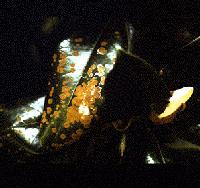 Living off the relatives: Cephaleuros virescens on Magnolia grandiflora © The American Phytopathological Society.
Living off the relatives: Cephaleuros virescens on Magnolia grandiflora © The American Phytopathological Society.A long time ago there lived a family of primitive plants.
One of the family -- a freshwater algae -- did very well for itself. It beget all of today's land plants, from moss to gladioli. Another -- a seaweed -- made the leap to land while staying true to its algal roots. It lay low on rocks and tree trunks. These distant relatives have similarities that may help to explain the secret of the land-conquering plants' success, researchers now report.
The advanced land plants and the more modest algae (the Trentepohliales ), independently evolved the same mechanism of cell division, Russell Chapman of Louisiana State University, Baton Rouge, told the annual meeting of the American Association for the Advancement of Science in San Francisco this week.
Chapman and his team were "really very puzzled, almost a little nervous", to find this strange correspondence. "It just shouldn't be there," he says, "these are very different organisms."
The type of cell division in question -- in which a disc-like structure called a 'phragmoplast' forms where the cell will divide -- seems to be fundamental to building complex, multi-cellular plants. "It is key to all the land plants; I think there are no exceptions," says Chapman.
Plant evolution researchers now hope to tap into the burgeoning stack of genomic data to track down the genes involved in phragmoplast formation in the two plant lineages, and maybe figure out what gave the successful plants their edge.
"We're trying to understand what it is about these organisms that allowed their close relatives to dominate the land," says plant biologist Charles Delwiche of the University of Maryland, College Park. "It [seems to be] a question of having the right skills."
DNA sequence comparisons have only recently put the Trentepohliales firmly among the green seaweeds. The few species that make up the group have managed to spread around the world, and live in temperate and tropical forests.
The fossil record shows that some other plants made it onto the land only to die out. No one knows why one group of land plants became so dominant. In the animal kingdom, by contrast, groups as diverse as crustaceans, molluscs and vertebrates made the jump to land successfully.
And no one knows when the Trentepohliales made their move. An answer may come from further analysis of DNA. Sometimes the genetic differences between species give a measure of the time since they last shared a common ancestor.
For a long time, researchers thought that land plants were descended from seaweed. Living on the seashore, drying out twice a day at low tide, they reasoned, would be ideal preparation for land life.
The recent DNA evidence has overturned this view, revealing that plants came ashore via freshwater. Chapman speculates that this may because seaweeds, adapted to life in salt water, could not take rain -- an inundation of freshwater.
